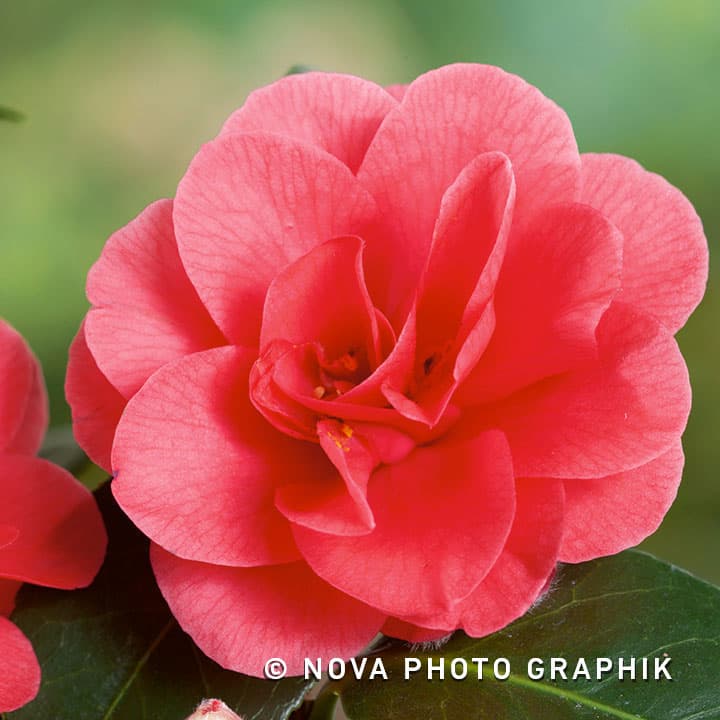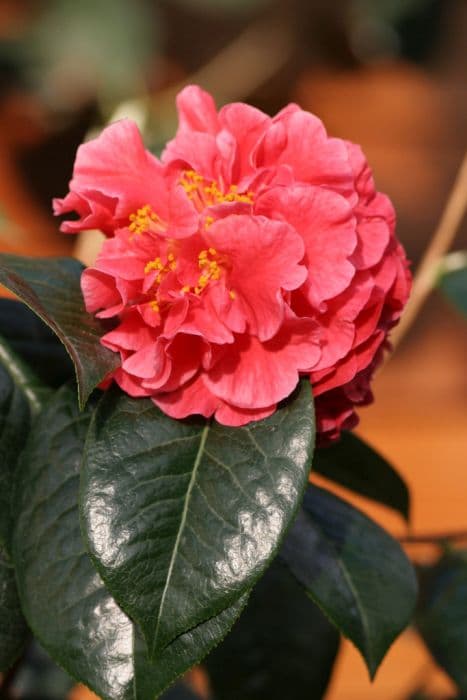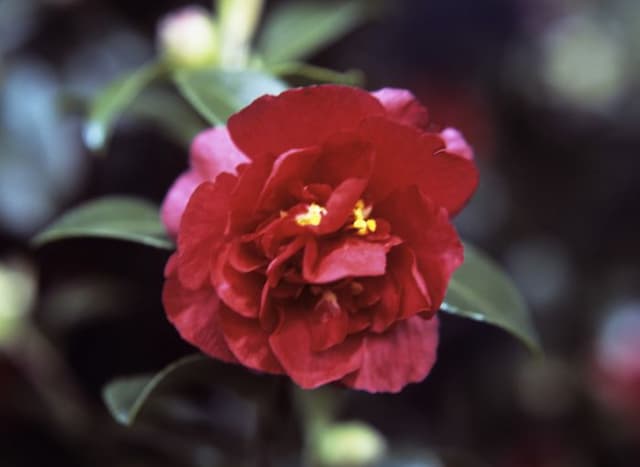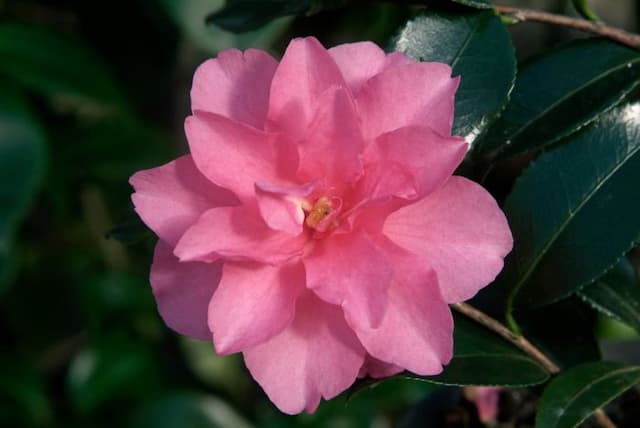Yunnan Camellia Camellia reticulata 'Mary Williams'

ABOUT
Camellia reticulata 'Mary Williams' is an ornamental plant known for its stunning flowers and glossy foliage. The flowers of this plant are usually large and showy, boasting broad petals that form an elegant, peony-like shape. The bloom color is typically a rich pink, which can have various shades ranging from soft pastels to more intense hues. Each flower is accentuated by a cluster of prominent, contrasting yellow stamens in the center, adding to its visual appeal. The leaves of 'Mary Williams' are dark green, thick, and leathery, with a shiny surface that reflects light, giving the plant a vibrant, lush appearance. They are oval-shaped with a slightly serrated edge, providing a striking backdrop for the vibrant blooms. The overall impression of Camellia reticulata 'Mary Williams' is one of elegance and exotic beauty, often making it a favorite among garden enthusiasts for its decorative qualities and the sophisticated ambiance it lends to any garden setting.
About this plant
 Names
NamesFamily
Theaceae
Synonyms
Yunnan Camellia, Reticulated Camellia, Mary Williams Camellia
Common names
Camellia reticulata 'Mary Williams'.
 Toxicity
ToxicityTo humans
The plant known as Ret
To pets
The Reticulated Camellia, or Camellia reticulata 'Mary Williams', does not have documented toxicity to pets such as dogs and cats. There are no specific symptoms of poisoning associated with this plant. The ingestion of any part of this Reticulated Camellia by pets is not expected to pose significant health consequences. Nevertheless, to prevent any potential digestive upset, pets should not be encouraged to consume ornamental plants. If a pet exhibits unusual behavior after ingesting any plant matter, consulting a veterinarian is recommended.
 Characteristics
CharacteristicsLife cycle
Perennials
Foliage type
Evergreen
Color of leaves
Green
Flower color
Pink
Height
10 feet (3 meters)
Spread
6 feet (1.8 meters)
Plant type
Shrub
Hardiness zones
7
Native area
China
Benefits
 General Benefits
General Benefits- Aesthetic Appeal: Camellia reticulata 'Mary Williams' is prized for its large, showy flowers which add a splash of color and elegance to gardens and landscapes.
- Long Blooming Period: This plant enjoys a longer blooming season compared to many other flowering shrubs, often from late winter to early spring, providing interest during a time when few other plants are in flower.
- Privacy Screen: With its dense foliage, it can serve as an effective privacy screen or hedge, blocking unwanted views and creating secluded areas in gardens.
- Shade Tolerance: It is capable of thriving in partial shade, making it suitable for planting under the canopy of larger trees or in areas with filtered sunlight.
- Drought Resistance: Once established, it has a good level of drought tolerance, reducing the need for frequent watering and making it suitable for xeriscaping in certain climates.
- Cold Tolerance: It is relatively cold-hardy, capable of withstanding cooler temperatures than some other camellias, which can extend its growing range.
- Wildlife Attraction: While not its primary benefit, the plant can attract pollinators such as bees when in bloom, thereby contributing to the health of the local ecosystem.
- Versatility: This camellia variety can be used in a variety of landscaping applications, from a standalone specimen plant to part of a mixed shrub border or container planting.
 Medical Properties
Medical PropertiesThis plant is not used for medical purposes.
 Air-purifying Qualities
Air-purifying QualitiesThis plant is not specifically known for air purifying qualities.
 Other Uses
Other Uses- Photography Interest: The striking blooms of Camellia can serve as an ideal subject for botanical photography due to their intricate petals and vibrant colors.
- Artistic Inspiration: Artists often use the complex beauty of Camellias as inspiration for paintings, drawings, and textile designs.
- Culinary Garnish: Petals of the Camellia can be used as an edible garnish for salads and desserts, adding a touch of elegance.
- Dye Production: The petals and leaves of some Camellia varieties can be used to produce natural dyes for fabrics or crafts.
- Ritual Uses: In certain cultures, Camellias may be used in rituals or ceremonies as symbols of love or devotion.
- Botanical Studies: Camellia offers an opportunity for botanical studies due to their extended flowering season and diverse range of cultivars.
- Floristry Training: As a well-known garden plant, Camellia is often used in floristry courses to teach students about flower arranging and care.
- Eco-friendly Confetti: Dried petals of the Camellia can be used as a biodegradable alternative to traditional confetti at celebrations.
- Perfumery: While not common, the essence of certain Camellia species can be captured and used as a component in crafting subtle, floral perfumes.
- Seasonal Festivities: In some regions, Camellias in bloom are a symbol of seasonal change and are celebrated during particular festivals or cultural events.
Interesting Facts
 Feng Shui
Feng ShuiThe Camellia is not used in Feng Shui practice.
 Zodiac Sign Compitability
Zodiac Sign CompitabilityThe Camellia is not used in astrology practice.
 Plant Symbolism
Plant Symbolism- Adoration: Camellias, in general, are often associated with adoration, conveying deep feelings of longing and desire towards someone.
- Perfection: Due to its impeccably formed petals and rich, vivid color, the Camellia symbolizes the pursuit of perfection in every aspect of life.
- Refinement: The Camellia reticulata 'Mary Williams', with its elegant appearance, represents sophistication and the refined beauty of the bloomer.
- Longevity and Faithfulness: The sturdiness and long-blooming nature of Camellias are indicative of enduring commitment and the will to stand the test of time, in relationships and life.
- Deep Desire: The lush, intense hue of the flower stands for a deep-seated passion and desire reserved for someone cherished.
 Water
WaterThe Camellia reticulata 'Mary Williams', also known as reticulate camellia, should be watered regularly to maintain moist, but not soggy, soil conditions. The plant benefits from deep watering, which can be achieved by slowly pouring water at the base until it starts to run off. This method encourages deeper root growth. It should be watered approximately once a week, but you may need to adjust the frequency based on weather conditions; less often in cooler or rainy periods and more frequently during hot, dry spells. Generally, 1 to 1.5 gallons of water per week suffices for a medium-sized shrub, and this should be increased if the plant is larger or in full sun.
 Light
LightReticulate camellia thrives in partial shade to filtered sunlight conditions. The best spot for the plant is one that provides protection from the harsh afternoon sun, yet allows for bright morning light or dappled sunlight throughout the day. Avoid placing it in deep shade or direct, full afternoon sun to prevent sunburn on the leaves and to ensure the plant has enough light for healthy growth and bloom production.
 Temperature
TemperatureReticulate camellias prefer temperate climates with temperatures ideally ranging between 60 to 80 degrees Fahrenheit. They can withstand minimal winter lows of around 10 to 15 degrees Fahrenheit, but prolonged exposure to these low temperatures may damage the plant. In summer, the plant can tolerate maximum temperatures of up to 100 degrees Fahrenheit, but it is important to protect it from extreme heat by providing adequate shade and mulch to help keep the root zone cool.
 Pruning
PruningPruning reticulate camellias is important for removing dead or weak growth, maintaining shape, and encouraging airflow within the plant. The best time for pruning is just after the camellias have finished blooming, usually in late winter or early spring. Thin out the inner branches to allow light to reach the center of the plant and prune any crossing or rubbing branches to prevent damage. Prune the plant lightly each year, focusing on shaping and health rather than size reduction.
 Cleaning
CleaningAs needed
 Soil
SoilRetuculata Camellia prefers well-draining, acidic soil with a pH of 5.5 to 6.5. A mix of 50% peat moss, 30% pine bark, and 20% perlite is ideal to ensure good drainage and aeration.
 Repotting
RepottingReticulata Camellias should be repotted every 2-3 years or when they outgrow their current container to ensure they remain healthy and have enough room for root growth.
 Humidity & Misting
Humidity & MistingReticulata Camellia thrives in environments with high humidity levels, ideally between 50-60%. Avoid placing them in dry or drafty areas to maintain optimal humidity.
 Suitable locations
Suitable locationsIndoor
Place Reticulata Camellia in bright, indirect light and maintain high humidity.
Outdoor
Plant in partial shade with shelter from strong winds and afternoon sun.
Hardiness zone
7-9 USDA
 Life cycle
Life cycleThe life of Camellia reticulata 'Mary Williams', commonly known as Yunnan camellia, begins with seed germination which occurs in moist, well-drained soil. After germination, the seedling stage involves the formation of primary leaves and establishment of the root system. In the vegetative growth stage, the plant develops a branching structure and mature leaves, with the growth rate influenced by climate, soil, and care practices. Following vegetative growth, the Yunnan camellia enters the flowering stage, typically in late winter to early spring, where it produces large, showy flowers that attract pollinators. Successful pollination leads to fruit development, wherein the fruits mature to form seeds that can be dispersed for new plant growth. As a perennial, Yunnan camellia can continue this cycle for many years, often requiring pruning and maintenance to sustain health and vigor.
 Propogation
PropogationPropogation time
Spring-Early Summer
The Camellia reticulata 'Mary Williams', also known as the Yunnan camellia, is often propagated by semi-hardwood cuttings. This is typically done during the summer when the new growth has matured and the wood has begun to harden. To propagate using this method, a cutting of about 4 to 6 inches (10 to 15 cm) is taken from a healthy branch. The lower leaves are removed, and the cut end is treated with rooting hormone to encourage root development. The cutting is then placed in a potting mix with good drainage and kept moist but not waterlogged. It's essential to provide a humid environment, which can be achieved by covering the pot with a plastic bag or using a mist system, until roots establish, usually within several weeks to a few months. This method is favored for retaining the true characteristics of 'Mary Williams' as it is a cultivar with specific traits that seed propagation may not preserve.









